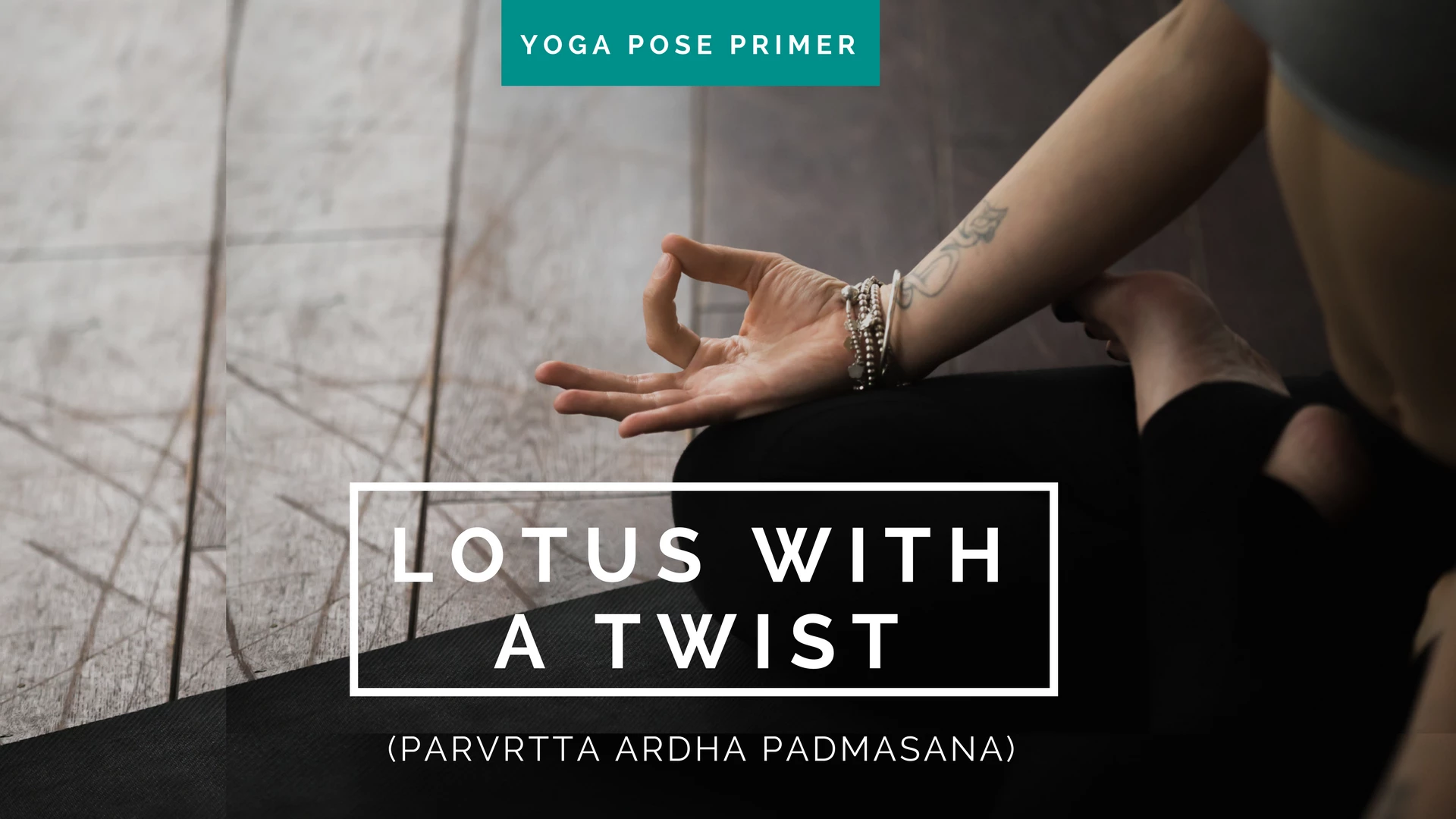Parvrtta Ardha Padmasana (Revolved Half Lotus): Lotus with a Twist

Padmasana (Lotus Pose) may be yoga asana’s most recognizable pose. This is a bit odd since many Westerners do not have hip joints that will perform the pose safely. Lotus Pose requires a whole lot of external rotation, more than many of our hip joints can muster.
Perhaps Lotus Pose became an asana icon because of the practice’s East Indian origins. My own completely anecdotal observation from time spent in India revealed that Indian hip joints appear to externally rotate much more easily and universally than those of my students in the U.S. Poses such as Baddha Konasana (Bound Angle Pose) and Padmasana looked consistently more effortless in Indian students.
A study by the Indian Journal of Orthopedics found that there are, indeed, evolutionary differences between Western and Eastern (South Indian) hip joints:
“The lifestyle and the social customs of the Indian population differ from that of the Western population. The hip joints of the Indian population would be evolutionally different from their Western counterparts since our population is more apt to floor level activities with external rotation of the hip.“
Even if Padmasana is less accessible to us in the West, we can still practice its many variations. Parvrtta Ardha Padmasana (Revolved Half Lotus Pose) allows us to practice externally rotating our hip joints, while enjoying an invigorating spinal twist. What makes this pose especially interesting is that the femur of one leg needs to externally rotate while the femur of the other leg internally rotates.
Spinal rotation is one of yoga practice’s great gifts: we don’t often twist our spines in everyday life, even though our thoracic spines are designed to do this. Asana practice gives us the opportunity to keep our spines supple and mobile by encouraging all types of movement, including twisting.
Parvrtta Ardha Padmasana is a complicated pose. It’s important to warm up before you practice. Here are a few suggestions for warm-up poses:
- Uttanasana (Standing Forward Bend)
- Baddha Konasana (Bound Angle Pose)
- Supta Ardha Padmasana (Supine Half Lotus)
- Supta Ardha Virasana (Supine Half Hero’s Pose)
Practice with care—or don’t practice Parvrtta Ardha Padmasana at all—if you have knee or low back issues or intervertebral disc problems. Do not practice spinal twists in the first trimester of pregnancy. Gentle twisting, not to your limit, is okay in the later stages of pregnancy.
How to Practice Parvrtta Ardha Padmasana (Revolved Half Lotus)
Props: nonskid yoga mat, one or two firm yoga blankets or yoga bolster, yoga block (optional)
- Sit on a nonskid yoga mat with your legs stretched out in front of you.
- Bend your right knee so that the heel is next to your outer right hip (as in Virasana (Hero’s Pose)).
- If this feels stressful or painful for your knee, try sitting up higher, on a folded blanket or two, so that your pelvis is higher than your legs. Or you can straighten your right leg out onto the floor and practice the pose with your right leg straight.
- Bend your left knee and cross your left ankle all the way across your right thigh as in Padmasana (Lotus Pose). Flex your left ankle as you place it on top of your right upper thigh.
- Your ankle should be fully resting on the thigh to avoid overstretching your outer ankle, which can compromise both your knee and your ankle. If the sole of your foot is facing upward, you may be causing stress in your left ankle or knee. If you can’t place your left ankle on top of your right thigh, place your ankle on the floor and press your left foot into your right inner thigh.
- You will likely be sitting solely on your left hip. Don’t worry about your right hip being on the floor in this position.
- Now check your spine: Are your lumbar vertebrae poking out? If so, sit higher on a folded blanket or two.
- Rotate your torso toward the left leg, allowing your pelvis to twist in the direction of your rotating torso. This means that your left sit bone will move back as your right sit bone slides forward.
- Place your right hand on the outside of the left thigh. Be sure to allow the twist to come from the spine, rather than pulling yourself into it with your arms. Please don’t inflict the pose on your body!
- Place your left hand on the floor to help you lengthen your spine. If it doesn’t reach the floor, place your hand on a block.
- If your arms are long, you may be able to reach around your back and grab your left foot with your left hand. If that’s not happening for you, return your hand to the floor or to the block to help you keep your spine long.
- Take 5 to 10 deep breaths, allowing your body to oscillate in and out of the pose slightly as you exhale and inhale.
- Return to the center. Stretch your legs out on the floor in front of you and sit for a few breaths, letting the effects of the asana settle.
- Repeat on your other side.
Here’s another yoga pose primer from YogaUOnline and special contributor Charlotte Bell – Garudhasana: How to Spread Your Wings.
Reprinted with permission from Hugger Mugger Yoga Products blog.
 Charlotte Bell began practicing yoga in 1982 and began teaching in 1986. She was certified by B.K.S. Iyengar in 1989 following a trip to Pune. In 1986, she began practicing Insight Meditation with her mentors Pujari and Abhilasha Keays. Her asana classes blend mindfulness with physical movement. Charlotte writes a column for Catalyst Magazine and serves as editor for Yoga U Online. She is the author of two books: Mindful Yoga, Mindful Life and Yoga for Meditators, both published by Rodmell Press. She also edits Hugger Mugger Yoga Products¹ blog and is a founding board member for GreenTREE Yoga, a non-profit that brings yoga to underserved populations. A lifelong musician, she plays oboe and English horn in the Salt Lake Symphony and the folk sextet Red Rock Rondo whose 2010 PBS music special won two Emmys.
Charlotte Bell began practicing yoga in 1982 and began teaching in 1986. She was certified by B.K.S. Iyengar in 1989 following a trip to Pune. In 1986, she began practicing Insight Meditation with her mentors Pujari and Abhilasha Keays. Her asana classes blend mindfulness with physical movement. Charlotte writes a column for Catalyst Magazine and serves as editor for Yoga U Online. She is the author of two books: Mindful Yoga, Mindful Life and Yoga for Meditators, both published by Rodmell Press. She also edits Hugger Mugger Yoga Products¹ blog and is a founding board member for GreenTREE Yoga, a non-profit that brings yoga to underserved populations. A lifelong musician, she plays oboe and English horn in the Salt Lake Symphony and the folk sextet Red Rock Rondo whose 2010 PBS music special won two Emmys.


